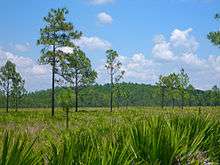Cypress dome

A cypress dome is a type of swamp, typically dominated by pond cypress (Taxodium ascendens). The trees at the center of the swamp grow higher than the trees at the edge, which forms a dome-like shape of treetops when viewed from a distance. Cypress domes form in flatland depressions in the Gulf coastal plain and southern Atlantic coastal plain, in the states of Georgia, Florida, Alabama, Mississippi, and Louisiana.[1][2][3][4]
Cypress domes form when pond cypress grow in shallow standing water. The ground level in the center of the dome may be several inches to a few feet lower than at the edge of the dome, but tree growth is more vigorous at the center of the dome. Thus, the treetops are higher at the center than at the edge of the dome.[5][1]
Cypress domes are the most common swamp habitat in Florida.[6] Most abundant in Central Florida, they also occur in other areas of Florida above the Florida Keys.[7]
Southern coastal plain nonriverine cypress domes are found throughout the southern coastal plains. Swamp tupelo (Nyssa biflora) and sweetgum (Liquidambar styraciflua) sometimes grow along with cypress.[3] These domes can be found in Eglin Air Force Base, and in numerous preserves including Cypress Creek Preserve and Conner Preserve. In North Florida, domes can contain pondspice (Litsea aestivalis), panhandle spiderlily (Hymenocallis henryae), and small-flowered meadow beauty (Rhexia parviflora).[1]
South Florida cypress domes are found in southern Florida, in particular in and around the Everglades and the Big Cypress National Preserve. They are distinguished from southern coastal plain cypress domes by the presence of tropical understory species.[4] These domes can have many-flowered catopsis (Catopsis floribunda). [1]
Dome swamps also provide breeding habitat for rare animals such as flatwoods salamanders (Ambystoma spp.), white ibis (Eudocimus albus), and wood storks (Mycteria americana).[1]
The University of Central Florida's literary magazine The Cypress Dome was established in 1990; a cluster of cypresses forms such a dome in the arboretum on campus.[8]
List of species
Plant species that occur in cypress domes include:
- Herbaceous species[1]
- toothed midsorus fern (Blechnum serrulatum)
- false nettle (Boehmeria cylindrica)
- sawgrass (Cladium jamaicense)
- Carolina redroot (Lachnanthes caroliana)
- taperleaf waterhorehound (Lycopus rubellus)
- maidencane (Panicum hemitomon)
- knotweeds (Polygonum spp.)
- beaksedge (Rhynchospora spp.)
- lizard’s tail (Saururus cernuus)
- cinnamon fern (Osmunda cinnamomea)
- royal fern (Osmunda regalis var. spectabilis)
- Virginia chain fern (Woodwardia virginica)
- Miscellaneous species[1]
- duckweeds (Lemna, Spirodela, and Landoltia)
- big floatingheart (Nymphoides aquatica)
- orchids (Orchidaceae spp.)
- bulltongue arrowhead (Sagittaria lancifolia)
- floating water spangles (Salvinia minima)
- sphagnum moss (Sphagnum spp.)
- alligatorflag (Thalia geniculata)
- wild pine (Tillandsia spp.)
- Shrubs (uncommon)[1]
- common buttonbush (Cephalanthus occidentalis)
- titi (Cyrilla racemiflora)
- St. John's wort (Hypericum spp.)
- Virginia willow (Itea virginica)
- fetterbush (Lyonia lucida)
- wax myrtle (Myrica cerifera)
- coastalplain willow (Salix caroliniana)
- Trees[1]
- red maple (Acer rubrum)
- pond apple (Annona glabra, South Florida)
- Coco plum (Chrysobalanus icaco, South Florida)
- loblolly bay (Gordonia lasianthus)
- dahoon (Ilex cassine)
- sweetbay (Magnolia virginiana)
- swamp bay (Persea palustris)
- slash pine (Pinus elliottii)
- Vines[1]
- white twinevine (Sarcostemma clausum)
- laurel greenbrier (Smilax laurifolia)
- Spanish moss (Tillandsia usneoides)
- poison ivy (Toxicodendron radicans)
See also
| Wikimedia Commons has media related to Cypress domes. |
References
- 1 2 3 4 5 6 7 8 9 10 "Dome Swamp" (PDF). Florida Natural Areas Inventory. June 2009.
- ↑ Lollar, Kevin (Oct 13, 2009). "Critters collected, counted in study of cypress domes". The News Press (Fort Myers, Fla.).
- 1 2 "Southern Coastal Plain Nonriverine Cypress Dome". NatureServe Explorer. Retrieved 5 February 2013.
- 1 2 "South Florida Cypress Dome". NatureServe Explorer. Retrieved 5 February 2013.
- ↑ "Types of Florida Swamps". University of Florida. Retrieved 2009-05-19.
- ↑ "Freshwater Swamps". SFRC Extension. University of Florida. Retrieved 2012-05-21.
- ↑ Casey, W.P.; Ewel, K.C. (1998). "Soil redox potential in small pondcypress swamps after harvesting". Forest Ecology and Management 112: 281–287. doi:10.1016/s0378-1127(98)00409-5.
- ↑ Oliver, Lance (May 13, 1990). "Imagination soars in UCF magazine". Orlando Sentinel.